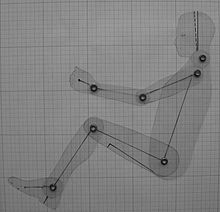Kiel doll
Kiel doll is the name of a manual, two-dimensional body outline template, which describes the anthropometric characteristics of men and women and their movement sequences ( kinematics ) in a simplified manner. The most important joints (hand, elbow, neck, knee, shoulder, hip and ankle joint) can move in two dimensions.
The dimensions of the Kiel doll are set out in DIN 33408. Other stencils are the so-called SAE stencil and the stencil from the University of Industrial Design Burg Giebichenstein .
origin
The Kiel doll was presented to the public for the first time in 1975. It was developed by the Anthropological Institute of the University of Kiel in the early 1970s under the direction of Hans Wilhelm Jürgens . This was preceded by extensive anthropometric studies on men and women, which summarized the so-called Kiel doll (average template). Analysis of motion sequences with regard to ergonomics and work processes complemented the development.
Areas of application
The Kiel doll quickly developed into the preferred instrument for designing driver workstations (bus drivers) and vehicle occupants in general. Ergonomic features such as headroom, seating position and accessibility of operating elements within a comfort area can thus be taken into account in the design phase (ergonomic package). Due to the extensive investigations into the development of this doll, a statement about the later suitability of the construction can be made very precisely. The main areas of application for this template are the pre-development and vehicle design of automotive companies, where an ergonomically sophisticated interior design (especially the seating position, H-point / R-point) and the determination of comfort fields (e.g. accessibility of the steering wheel) are extremely important for the occupants.
Appearance
The Kiel doll is mainly used in its form of the 5th percentile woman (ie only 5% of all women are smaller) and the 95th percentile man (ie only 5% of all men are taller). A statistically sensible compromise has thus been found for the dimensions of the doll.
In terms of its appearance, the Kiel doll is a stencil made of transparent, thin material (often Makrolon ) with different scales (often 1: 5 or 1: 2). The joints described above are rotatably arranged. Depending on the application, different lines, angles and points can be found on the template, so that a desired seating position with the corresponding comfort levels can be quickly set.
application
Once the setting has been made, the contour of the doll is recorded on the package plan below (on the same scale as the doll). This enables initial statements to be made about the arrangement of the imaginary constructions. If the manikin is further adjusted to the minimum or maximum position of the extremities, so- called comfort fields can be determined with the aid and drawing of the body kinematics (turning circle, head circle, etc.) and the auxiliary geometries marked on the template. In these comfort fields then z. B. frequently used controls (z. B. clutch pedal) can be placed. Otherwise ergonomic and safe operation is not possible.
present
The manual two-dimensional method of the Kiel doll is hardly used today due to the dominant use of CAx tools. Computer aided it predominate, three-dimensional programs such ANTROPHOS or RAMSIS ( R echnerunterstütztes A nthropologisches M athematisches S ystem for I nsassen- S imulation). With this, a wide variety of human models can be simulated and played in very quickly, while the Kiel doll only represents an average male and female type.
